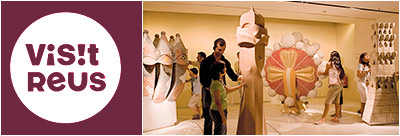All schools that wish to take part in these activities during this school year will be able to do so.
This is an inclusive project in collaboration with the Taller Baix Camp.
The result is a transversal project in which learning is carried out in different areas and adapted to the curricular competencies of each school year.
Since it opened its doors to the public in the summer
of 2018, Casa Navàs has been clear that one of its objectives must be to make
students discover what Modernism is, what is the presence of this movement in
the city of Reus and Catalonia, and what is the value of Casa Navàs as the only
European modernist building that preserves the original interior. Following in
this footsteps, guided tours have been programmed from the outset for all the
schools that have requested them.
Now that the guided tours have been consolidated, the
time has come to go a step further and launch an educational project that
allows children to get to know Modernism and, more specifically, Casa Navàs,
while they make a special visit with games as the guiding theme. The fact that
learning is based on play and logical deductions is fundamental because the
children will pay much more attention and the knowledge, they will assimilate
will be greater. The project is being launched this October.
For all pupils to get the most out of the experience,
three different educational projects adapted to their age are proposed. Thus,
there will be a first program dedicated to children aged 4 to 7 (P4, P5, 1st
and 2nd year of primary school), another for children aged 8 to 12 (3rd to 6th
year of primary school), and the last one for young people aged 13 to 16 (ESO).
It is important to note that this educational project
has been developed by the staff of Casa Navàs in coordination with ANS
Educació, which has provided advice and guidance. The result is a transversal
project in which learning is carried out in different areas and adapted to the
curricular competencies of each school year.
Collaboration
with Taller Baix Camp
In addition to delving into the history of the
country’s art, the school visits to Casa Navàs also aim to be rich in values.
That is why we also encourage students to reflect on class differences, the
role of women in the society of a century ago, and companionship. With this
premise as an objective, collaboration with the Taller Baix Camp has been
forged.
The users of the Taller Baix Camp will play a
significant role in the Casa Navàs educational project. Specifically, they will
become some of the actors and actresses who will guide the pupils through the
interior of the house in two of the three projects we are presenting. In the
visit dedicated to the youngest members of the family, the users of the Taller Baix
Camp will play the role of the magical elves who accompany the magical gardener
of Casa Navàs. As for the visit dedicated to primary school pupils, the entity’s
users will become this modernist jewel’s service staff. Once the visit is over,
they will also take part in the activities in the shop and will lead, for
example, a handicrafts workshop.
This is an incredibly positive experience for the
members of the Taller Baix Camp, as they will work on their ability to adapt
and improve their communication and social skills. It will also be very
enriching for the students who visit the house because, indirectly, they will
receive a message that promotes the values of equality and respect. In the same
way, the staff of Casa Navàs will have to adapt to the ways and rhythms of work
of these new colleagues.
Children’s
Visit: The magical garden of Casa Navàs
·
Target
group: P4, P5, 1st and 2nd year of primary school.
·
Main
tool: a story
·
Guide:
Magic gardener of the Casa Navàs
·
Duration:
40 minutes of tour + 30 minutes of workshop
·
Previous
work in the classroom: no
·
Price
per pupil: 5 €
A special gardener, full of colour and fantasy, will
lead the small visitors through the interior of the Casa Navàs while explaining
its history through a story and some magic tricks. Through the senses -sight,
smell, hearing, and touch- and while playing and looking for shapes, colours,
and elements of nature, children will discover the magical garden of the Casa
Navàs built by Lluís Domènech i Montaner.
As well as focusing on Modernism, during the visit
they will also work on fears, as normalised feelings among adults and children
alike. Through a magic cloth, which will act as a guide and which they will
then take home, they will reflect on the fear and will be given tools to help
them deal with it. This is an open and participative visit in which the pupils
will interact and share their impressions with the gardener who accompanies
them to encourage oral expression and the ability to share opinions and
feelings.
Ø The workshop: while half of the
class is visiting the interior of Casa Navàs, the other half of the group will
be in the Casa Navàs shop in workshops on painting and the construction of
stained glass (coloured paper) and mosaics (stickers) inspired by Modernism and
Casa Navàs.
Primary
students’ visit: A typical day at Casa Navàs
·
Target
public: Primary school’s 3rd, 4th, 5th, and 6th grades.
·
Main
tool: visit guided by a theatrical character.
·
Guide:
owners of Casa Navàs, Joaquim Navàs/Josepa Blasco + governess/butler.
·
Duration:
55 minutes of tour + 45 minutes of workshop
·
Previous
work in the classroom: yes
·
Price
per pupil: 6 €
This guided tour, full of theatrical touches, aims to
give pupils a first-hand look at the day-to-day life of a modernist house. The
first thing we need to understand is that not all the people who lived in the
house enjoyed the same social status and, consequently, did not use the same
rooms or have the same routines. For a
better understanding, the pupils will follow two routes led by two different
characters. During the first part, they will be accompanied by the master or
mistress of the house and with them, they will enter the noblest rooms of the
house; then it will be the servants who will take over the visit to accompany
them to the other rooms of the house, less frequented by the masters, such as
the kitchen or the sewing room. Thanks to the accompaniment of these two characters
with such distinct roles, the pupils will be able to appreciate the everyday
life of the modernist bourgeoisie. Naturally, the guides will take advantage of
the visit to the different rooms of the Casa Navàs to explain their history and
the curiosities they hide.
As if that were not enough, during the tour of the
interior of the house, the pupils will find wooden tablets with phrases
inscribed on them, such as: “Casa Navàs begins to be built”,
“Joaquim Navàs dies” or “A bomb causes damage to the
house”. When the visit is over, they will go to the Casa Navàs shop with
all the wood collected. There, an invention created for the occasion will be
waiting for them: the chronologicometer! The idea is that they place the
timbers on the timeline of the chronologicometer; only if they are in the right
position will the green light go off, indicating that the enigma has been
correctly solved. In this way, the pupils will also work on historical dates
and time relationships.
Ø
The
workshop: while half the class
visits the interior of Casa Navàs, the other half of the group will be in the
Casa Navàs shop with games that serve to reinforce all the learning acquired.
Ø Previous work at the school: To enrich the
experience at Casa Navàs, a dossier has been prepared for the pupils to work on
in the classroom before the visit.
ESO’s
Visit: Casa Navàs and time
·
Target
public: 1st, 2nd, 3rd, and 4th ESO (compulsory secondary education)
·
Main
tool: escape game
·
Guide:
Casa Navàs guide
·
Duration:
55 minutes of tour + 45 minutes of workshop
·
Previous
work in the classroom: yes
·
Price
per pupil: 7 €
Older pupils will have to use their brains a lot if
they want to successfully finish the visit to Casa Navàs, as what is proposed
to them is an escape game! The story begins with a great mystery: the spirits
of the people who have lived in Casa Navàs are trying to communicate something
to the visitors. Casa Navàs is full of objects that appear without reason:
boxes, cardboard, signs… we don’t know what’s going on, but it’s clear that
the ghosts want the pupils to follow the clues with some objective in mind.
With the escape game as a premise, the students will
go through the interior of Casa Navàs while they learn about the history, who
the architect was, which craftsmen worked there, and what materials they
used… They will not only learn more about this emblem of Domènech i Montaner
but also about Modernism and the impact it had on the city of Reus.
To
solve the enigmas that will allow them to move from room to room, the students
will have to use linguistic, mathematical, and logical resources… Besides,
they will also have to debate among themselves and reach a consensus to come up
with a unified definitive answer. Working in an escape game format aims to
enhance the students’ meaningful thinking, working from a distinct perspective
that involves more active results such as research, coordination between
groups, leadership, or motivation.
Ø
The
workshop: while
half the class visits the interior of Casa Navàs, the other half of the group
will be in the Casa Navàs shop with games that serve to reinforce all the
learning acquired.
Ø Work before the school: as with the primary
school pupils, a dossier has also been prepared for them to work on in the
classroom before the visit. It is important to stress that working on the
dossier in class is not compulsory for the visit, but it is highly recommended to
learn and make the most of this experience.
Budget
Developing
an educational project of this nature has involved many months of work by the
team at Casa Navàs and ANS Educació. The project began to take shape in
November 2021 and was completed in September 2022. During the process, pilot
tests were carried out with pupils from the Isabel Besora School and the Roseta
Mauri Secondary School in Reus and with groups of young children.
Designing the project, developing it, making the
costumes, and buying all the materials necessary for its execution have had a
total cost of 16,800 euros. The “la Caixa”
Foundation, through CaixaBank, contributed 6,000 euros, Reus City
Council 2,500 euros and the rest of the budget was covered by Casa Navàs.





